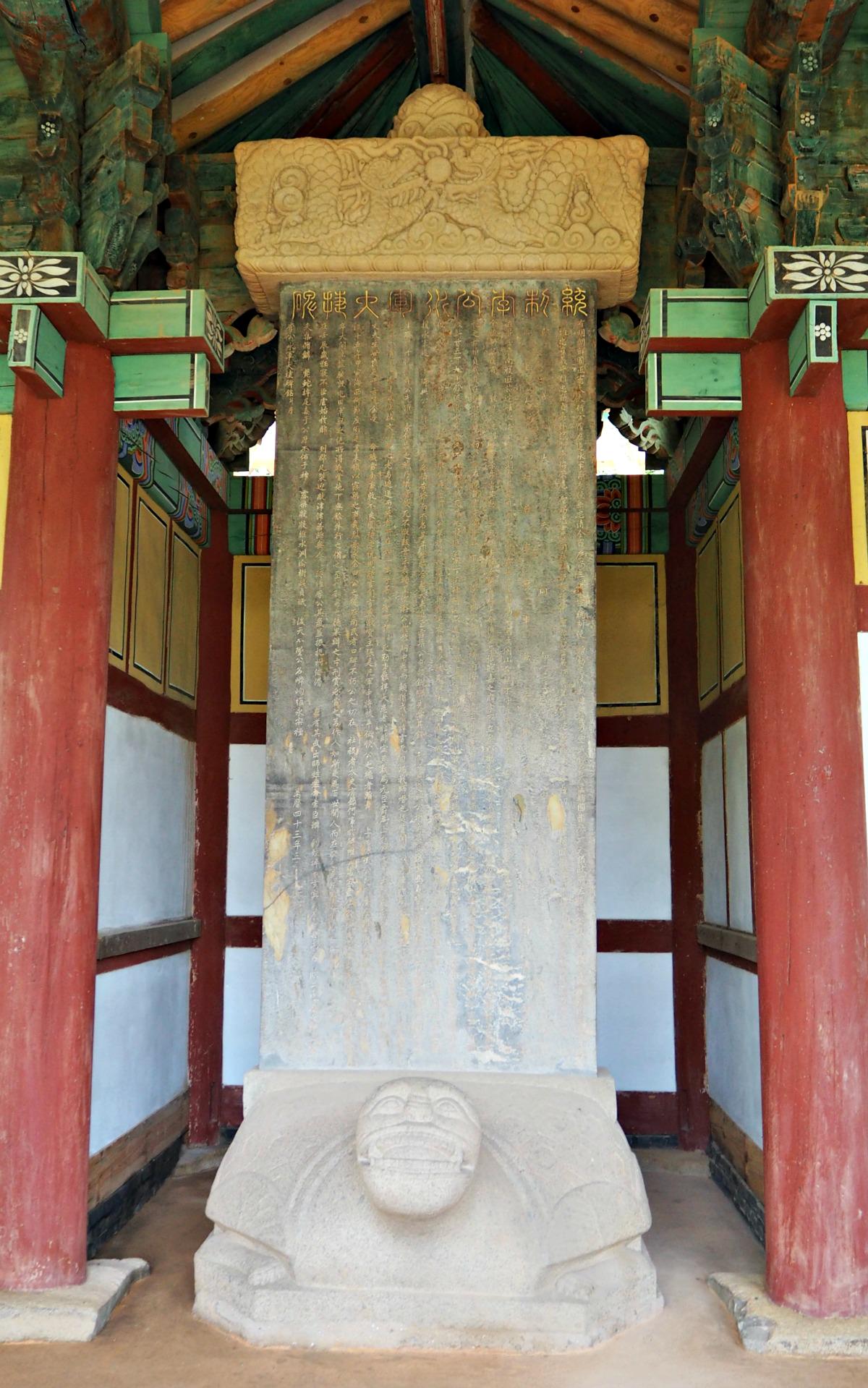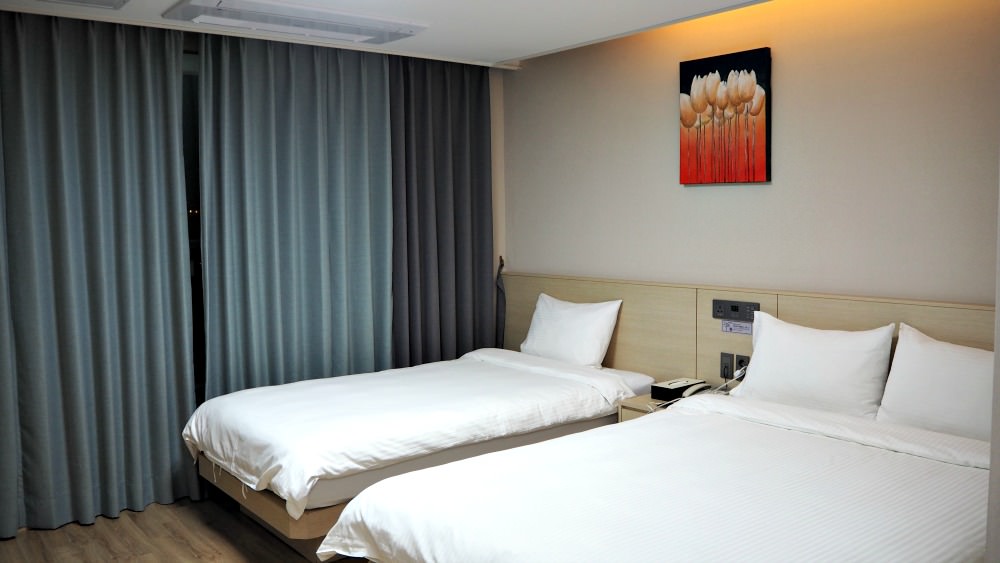Yi Sun-sin Victory SteleS
 Yi Sun-Sin Victory Steles, Yeosu City
Yi Sun-Sin Victory Steles, Yeosu CityYi Sun-SIn Victory Steles
The Yi Sun-sin Victory Steles Pavilion is a historically interesting and relevant structure and place in the hill of Yeosu City.
The pavilion overlooks the 'yeo' (beautiful) 'su' (water), the beautiful sea, of Yeosu City and the Hallyeohaesang National Park.
The Yi Sun-sin Victory Steles is a national treasure that portrays national independence and bravery. The site symbolizes courage, freedom, and victory over foreign invaders.
The site is called Gosodae. It was here that Admiral Yi Sun-sin gave military orders.
Inside this site, you can see the three steles: Stele of Victories, Dongnyeongsogalbi Stele, and Tarubi (more descriptions below).
I am fortunate to have spent time and explored the site, which is located just opposite the related historic site--Jinnamgwan Hall.
 Close up view of the top of Yi Sun-sin's victory stele
Close up view of the top of Yi Sun-sin's victory steleI would not have missed the opportunity if the Jinnamgwan curator didn't tell me about this memorial site. She was very persistent and was glad she did ^^.
Yes, I went, and here's my brief information...
- How Far: 4-5 hrs from Seoul or 1 and a half hrs from Gwangju City
- Transportation: Buses, Fast Train (or airplane from Seoul to Gwangju then bus), local bus
- Location: Yeosu City
- Other Attractions: Jinnamgwan Hall, Yi Sun-sin Square, Odongdo Island, Jasan Park, Yeosu Cable Car, etc.
- Where to Stay: Yeosu accommodations
That's right! It is very accessible as the transportation system in South Korea is well-established. You can get around pretty quickly and without having to wait for your next bus or train.
 The street view from the site overlooking the Jinnamgwan Hall
The street view from the site overlooking the Jinnamgwan HallTo See at Yi Sun-sin Victory Steles Garden
Yes, I call it a memorial garden because it is like a garden (not really a flower garden per se). Although I didn't see any flowering plant (it was Fall season), I presume they planted beautiful plants that bloom flowers during the Spring.
Entrance Gate
The traditional Korean gates are always attractive for me to watch. Of course, you can see them almost everywhere, but they don't bore me.
Probably because I somehow understand its historicity, meaning, and symbolisms (I'll write about this later on).
So, just like other gates, the Yi Sun-sin Victory Steles entrance gate is your only way to get inside.
BUT, for me, it is not only a passage but a symbol and gesture that you, as a visitor, must honor and pay tribute to the symbolic victory treasures inside the site.
If you are not ready to pay respect and honor the place, then maybe you should not enter.
And for you to understand and appreciate the meaning and symbolism of the site, you might have to learn a bit of history about this national hero (more on this below).
 The elevated gate of Yi Sun-sin Victory Steles
The elevated gate of Yi Sun-sin Victory StelesGreen Lawn. Yes, since I paid respects and explored the site during early Fall, I could still enjoy the green grass of the flat ground in front of the structure that houses the three steles.
The patchy concrete blocks can serve well, mainly when the ground is wet or icy. By the surrounding walls, you can also see some trees, some of which bear flowers during the Spring season.
 The garden and pavilion that houses the victory stele
The garden and pavilion that houses the victory stele Korean descriptions of the stele and site
Korean descriptions of the stele and site Old Zelkova Tree beside the pavilion
Old Zelkova Tree beside the pavilionOld Tree. On the left-hand side of the structure, facing the entrance gate, you can see and old tree. It is believed to be 270 years old when it was first officially registered in 1982.
The tree, a Zelkova species, is about 22 meters high.
I found it interesting to see ancient trees in historical places, such as in old temples.
Victory Memorial Steles
 Yi Sun-sin Victory Stele, Yeosu City
Yi Sun-sin Victory Stele, Yeosu CityThree steles are being housed in this memorial site. As you can see, the granite steles are under the protection of a traditional Korean-style building.
A Korean house with this similar design is called 'hanok' in the Korean language (which is now, sadly, not a traditional design in Korean houses or apartments).
The stele of the left, when facing the entrance gate, is called the Dongnyeongsogalbi. This stele records the reasons why the main stele (Victories Stele at the center) was erected.
The stele on the right, when facing the entrance gate, is called the Tarubi. His followers created this stele after his death in the Battle of Noryang.
And the stele in the middle, the tallest stone stele in the country, is specially dedicated to the hero himself, Admiral Yi Sun-Sin.
It is the Stele to Victories of Admiral Yi Sun-sin, and obviously the central stele in this site.
The stele looks grand and imposing. I believe it's because of the person's stature and achievement in life. He was an example of an altruistic person--one who thinks not of himself but for others, the people and nation.
Steles Inscriptions
Inscriptions: Stele to Victories of Admiral Yi Sun-sin
"Erected in 1615 to commemorate the achievements of Admiral Yi Sun-sin and his crews, this is the tallest stele in Korea.
After being appointed Army Commander-in-Chief of Hwanghae-do Province, Yu Hyeong, who served under Admiral Yi Sun-sin, sent the best quality stele stone available in Hwanghe-do here for the stele dedicated to Admiral Yi Sun-sin. Yi Hang-bok, a framed literati-scholar who served as prime minister, composed the epitaph, which was written by Kim Hyun-sung, the most brilliant calligrapher of the time.
In 1942, a Japanese police chief in Yeosu demolished the stele pavilion and hid both this stele and Tarubi. They were later found on the ground of Gyeongbuk Palace in Seoul in 1946 and restored to their present place in 1947."
Dongyeongsobalbi inscriptions
 Dongnyeongsogalbi (Stele)
Dongnyeongsogalbi (Stele)"Built in 1698, Dongnyeongsogalbi bears an inscription stating the reasons for (the) erection of the Stele to Victories of Admiral Yi Sun-sin in 1615, names of the people who joined the erection of the stele, and the difficulties encountered during the process, which were recorded by Sim In-jo, a magistrate of Jinan."
Tarubi inscriptions
 Tarubi - Stele for 'shedding tears'
Tarubi - Stele for 'shedding tears'"Tarubi was erected by subordinates of Admiral Yi Sun-sin in 1603 in tribute to him. Taru meaning 'shedding tears,' was taken from an old Chinese saying, "He who does not shed tears after reading this stele is not loyal enough." The loyalty of Admiral Yi's men is almost palpable in the name of the stele".
Surrounding Views. Yes, from where you stand, you will have great views of Yeosu's panorama, views of the bridges, islands, and sea.
A beautiful view of the port areas, small buildings, and the streets can make one feel great. Such views are accessible from the entrance gate area.
 Yeosu 'Bambada' (Yeosu's night light views)
Yeosu 'Bambada' (Yeosu's night light views)Mural Village. The mural village is located close by the memorial site. Go to your right and enjoy some neat and well-managed narrow paths leading to the corners and nooks of the village with a mixture of traditional and some modern but small houses.
I hope that's useful and essential information.
Now, let me describe a bit about Yi Sun-sin to help you get to know a bit and appreciate this hero. And probably, you will start thinking of exploring this place, and Yeosu.
Admiral Yi Sun-sin Brief Background
 Statue of Admiral Yi Sun-sin at Jasan Park, Yeosu
Statue of Admiral Yi Sun-sin at Jasan Park, YeosuYi Sun-Sin was a Korean naval commander. He was born on April 28, 1545, and died during the battle on December 16, 1598.
Admiral Yi Sun-sin became famous for his victories against the Japanese fleet that invaded Korea during the Imjin War in the Joseon Dynasty period.
It was known that Yi was not trained as a naval officer, but the enemies at sea never subdued him. Under his command, it was believed that he never lost a single ship.
Most of his battles happened in Yeosu, where he also established his naval control center, which is called the Jinnamgwan Hall.
Admiral Yi Sun-sin held a title, Samdo Sugun Tongjesa, which means "Naval Commander of the Three Provinces." Indeed, he was protecting three provinces in Jeolla Province. The title was used for the Korean navy commander until 1896.
Throughout his service, Admiral Yi fought more than twenty times. Most of these naval engagements were against the Japanese.
Admiral Yi's most famous victory happened at the Battle of Myeongnyang. It was believed that 133 warships of the Japanese outnumbered his fleet of 13 warships. Despite that overwhelming situation, he successfully destroyed 30 Japanese warships and himself without losing a single ship.
However, his service and bravery ended when he died of a gunshot wound during the Battle of Noryang on December 16, 1598.
Due to his victories, he was honored and given titles such as the Duke of Loyalty and Warfare (Chungmugong), First Class Military Order of Merit (Seunmu Ildeung Gonsin), and posthumous offices--Prime Minister and Prince of the Court from Deokpung.
Of course, the Yi Sun-sin Victory Steles garden is one of the symbolisms that people recognized his achievements, although the royal court didn't officially acknowledge during his period.
I hope this has made you start thinking about visiting this historical area in Yeosu. I would be glad to answer if you have questions or any clarifications.
Thanks, and enjoy your travels.
Where To Stay?
 I stayed at this hotel overlooking the sea, and it was beautiful at night
I stayed at this hotel overlooking the sea, and it was beautiful at nightWelcome to Yeosu City, a stunning and highly sought-after destination. This city is a unique blend of serene landscapes and vibrant culture, offering a charm that is truly one-of-a-kind. If you're planning a visit, consider extending your stay to fully immerse yourself in this unique charm.
For a truly indulgent and pampering experience, be sure to explore the range of hotels in Yeosu City. They offer well-appointed rooms, top-notch services, and excellent facilities, ensuring your stay is comfortable and memorable.
Whether you're seeking a tranquil retreat or a luxurious escape, the hotels in Yeosu City offer a diverse range of options, each with its unique charm. Take your time to find the perfect accommodation and make the most of your visit to this beautiful city.
Book or reserve your room now! Click and find out below.
- Shilla Stay Yeosu
- Yeosu Expo Utop Marina Hotel Resort
- Yeosu Venezia Hotel&Resort
- Yeosu Hotel Haven, Yeosu-si, South Korea
- Ramada Plaza by Wyndham Dolsan Yeosu
- Benikea Hotel Yeosu
And you can find more hotels in Agoda.com using the Search Box below or above this article.
Please, enjoy your travels!
- Home
- Jeollanamdo Attractions
- Yi Sun-Sin Victory Steles
Get Exciting Activities
Book one of our exciting activities today to experience the thrill of a lifetime! Take advantage of this opportunity and secure your spot in advance.
Hotel Map Guide
Find your affordable, accessible, and comfortable hotel in Seoul at Agoda.Com. See the hotel map below...
Hotel Booking Guide
Find affordable and amazing hotels on Agoda.com using the search box below. Book now to enjoy great discounts and save!







New! Comments
What do you think about this page? Leave me a comment in the box below.